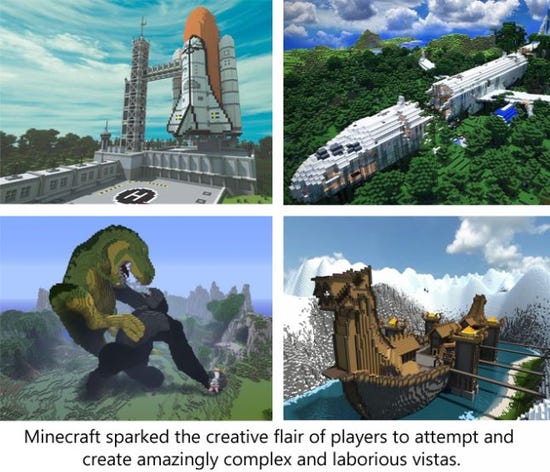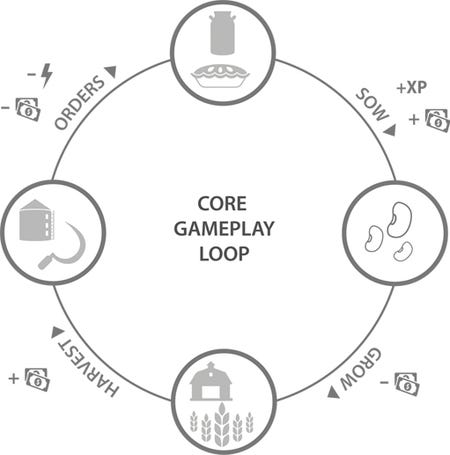Move over Minecraft: Monetising new wave of user generated content!
2017, What does the future and success of UGC games looks like? A deep look at UX of 4 games that leverage the power of user generated content, empowering users to create content for monetisation, disrupting the way millennials consume stories and fiction


Minecraft sparked the UGC revolution online in 2009. But 8 years on, what does the future look like?

Minecraft created the original legacy of a true open world sandbox where players created the immersive worlds and devs. just provided the tools, resulting in an explosion of unimaginable and impressive creativity by people.
Landscape of User Generated Content (UGC) is changing, and fast! The opportunities to tap in to a digital market where consumers become producers or 'prosumers' is on the horizon.
How UGC driven games differ from traditional games
Traditionally most game genres have rigid pre-defined core mechanics. The CORE loop which makes players habitual to the game and then set them on a progression path using a progressively difficult curve. While most games benefit from having an addictive core mechanics, it is generally agreed among devs. that a good long-term sustainable game needs to have a 'META Game' that emerges over time and is mostly driven by players rather than core mechanics driven by game designers.
The META allows players to exercise influence over existing design and provides a sense of contribution and having more control and influence over the game's world.

Core Loop - In the farm game example above, player has to plant crops, make goods and fulfil orders to earn cash, level up and buy seeds etc. to progress. This sets him on a rigid path set by game devs.

Meta Loop - But players knowing whiach crops and orders they need to quickly level up can set up multiple accounts/farms on other devices and use those farms to produce and accelerate crops for his primary farm by exclusively trading with himself. This way, the player has found a way to level up and progress faster than the rate expected by devs. mass producing more resources then his primary account/farm can produce.
Meta game can vary in nature across game genres and affect different games in different ways, but primarily it involves bending or creating of rules by players themselves. This itself, in ways, differ from the rules set by the core loop.
But in a UGC driven game 'Meta' may well be the game itself
Let's look at 4 mobile apps that have their vast majority of core content created.
"By the players, for the players" and the devs. mange to monetise it handsomely!

Daily rank & revenue charts. Source - Thinkgaming
Hooked - Chat Stories
This bare bones 'text messaging' stories format app is disrupting the millennial's fiction reading habits by large.

The app has a minimalistic 'no nonsense' interface - just images and a story title. Click a story and you will see a familiar messaging app interface with dialogues to keep reading. A Simple tap and the next line of message will appear. Thats it!

Even though it sounds dead simple, this is the way teens and millennials are habituated to consume mega bytes of information today - messaging and texting.

Hooked is essentially breaking apart bulk-sized story content that you see on kindle or iBooks and turning them into bite-sized text snippets for modular consumption.
Hooked taps into story telling by looking at teens & millennials pre-dominant information consumption pattern - Texting - and using it as an base to launch their platform.
Hooked devs., through extensive user testing, figured out that next wave of story consumption is not in bulk sized paragraphs or even short paragraphs, it was getting rid of narrative altogether!
Hence, the app presents info in short SMS formats, which is how you read their stories.
But the best part is most of these stories are written by users themselves.

Hooked encourages players to write their own stories and publish in 3 easy steps (as above). The app has a plethora of popular user generated stories at this very moment.
Engagement
Another interesting and noticeable stat is the community engagement these stories are generating:


Sheer amount of comments from genuine users on the Hooked chat stories itself is mind boggling. To be clear, these comments (17K/361 as in the screenshots above) are not on the app store but inside the app itself.
I am yet to see this kind of feedback from player inside any app or game!
Just to give you some perspective, I randomly picked a popular trending story on Medium - a well established blog and story telling medium that shows following average "likes / comments" stats:

Which, you can see, is way below the buzz than randomly chosen stories I picked on Hooked above are generating! This is the kind of engagement that forced Facebook into buying Whats App and Instagram. Fiction and story telling publishing houses better take note, this trend is here to stay.
Founders are also using this platform to test which stories, themes and formats appeal to the millennial and possibly use the data to help Hollywood figure out their best scripts and draw them to Movie halls.
Design Home
Crowdstar and Glu mobile are targeting an audience who aren't much into games. As a self-expression of creativity, the devs. just provide an array of tools (furniture in this case), not unlike Minecraft.

Players need to take part in 24 hour challenges ranging from indoor to outdoor home decor. As soon as they choose a challenge, they get an inventory with free and paid stuff that is used to decorate and complete the challenge.
Build your dream decor and enter it in live polls where other players will vote and based on the outcome, both you and other players will get game resources.

It's not surprising to see majority of these players are non-gamer women demographic who like to express their creativity and see latest trends. But what's interesting is that the furniture players used actual 3d models from real world brands. This helped players try and test out (and even purchase if they want) real items for their home if they so wish to.

This is exceptional cross selling and also an example of how real world brands can use their products to try out & entertain users virtually, convincing them to buy for real.
Interesting thing is they are not only monetising the 3D models of their products virtually in game but also selling the real product to the users.
Virtual goods so far have been quiet distinct from real world goods but this kind of cross-selling allows brands to sell and monetise their inventory both virtually as well as conventionally.
Episodes - Choose your story.
I have already done an in-depth pros and cons article on this app back in January and since then it has been steadily climbing up the app store. Full article link below:
https://www.linkedin.com/pulse/you-pay-2-kiss-game-character-episode-choose-your-story-om-tandon

This game is another spin-off on story telling and narration platform like Hooked but mainly targeted at teens and tweens. With richer graphics and images, the app utilises an interface and model similar to 'time shifted media' like Netflix and Hulu.
The twist in Episodes is that stories branch off based on players decisions at most opportune times (some of them cost money albeit).
But a lot of stories are driven by users themselves and the app offers a dedicated web platform for players to write and self publish their own stories.

You can read more about the platform here
Roblox - Taking a leaf out of LEGO's book
Roblox is a user-generated massive online multi-player social gaming platform which allows kids and teens to create custom games and play it with their friends.

Roblox started as a web based platform where users have LEGO like characters and a sandbox editor that can be used to create simple to complex games.
It seems they are in process of adapting to mobile, but (as you can see from screenshots above) they are carrying strong legacy from their web portal as the UX & UI for mobile leaves much more to be desired.
For example: The home screen selection menu is in portrait mode but as soon as you select the game, it turns landscape! (But note this article is not a UX Review :)

Here is a game that I tried out where you have to serve customers pizza and drinks as they walk in and collect cash, much like 'Cooking Dash' and games of similar genre. The only difference is this one was put together by a kid using an in-game editor provided by the devs!
The game does feel buggy with mish mash of dialogues and you can do things like jumping on top of a counter etc., everything you can literally do in an open world sandbox. But despite these flaws, the maker platform is a hit with kids and Roblox is definitely on the road to refining the experience and solving these issues as they grow. I am sure of this.
As far as the point of this article goes to show how UGC is propelling stellar growth for devs. through player generated content, Roblox is getting it right!
UGC Challenges
Sounds too good! Planning to jump on the bandwagon? - Wait!
It may seem easy to develop UGC geared platforms but the genre comes with it's own set of harsh challenges:
Monitoring the quality of content produced, as seen with Roblox example. The content produced may not be as finessed as industry standards.

Compare the visual quality and aesthetics of a game level built by an user on Roblox above to the beautifully put together level designed by Disney artists in Club Penguin below:

Ironically, Club Penguin has shut down recently, while ROBLOX is thriving (for entirely different reasons though). Point being, it can be quiet challenging to control the quality of content generated when amateur users are in control of content pipeline.
Controlling the nature of content produced: This is especially true of story-led platforms like Hooked and Episodes where players come up with stories that are sexist, controversial or based on suggestive 'trigger themes' with the motive to gain popularity and devs. may not have enough resources to vet them out.
Episodes Example:

Hooked Example:

To be fair I have seen increasing attempts from devs. putting in warnings etc. but this is a larger issue that needs monitoring and stronger age gating - from both parents and dev. side.
Undesirable Meta: As UGC driven content platforms relies heavily on players creating, and in a way, distributing the content by self marketing. It exposes a lot of creation tools and creative control into players hands making it easy to exploit and manipulate existing rules and any inherent flaws which every software has to some extent.
Mass Cloning
Needless to say, in today's world especially on app stores, any successful idea or app is cloned overnight. If you don't adapt fast enough or your tech is not complex enough to mimic proprietary, you risk loosing chunks of market share.
You can see below some of the clones of both Episodes and Hooked are already gaining popularity and eating in to their market share.


Why Now?
Question: UGC model has been around for a while. WHY is there such a huge demand now?
1) No more shame in amateur creations
Thanks to mass adoption and usage of social media platforms, people are no longer afraid of sharing amateur videos, images and other content on social media like FB, Snapchat, Instagram, LinkedIn, Youtube, Whatsapp which thrive on user-generated content.

People were more reluctant and let down by amateur attempts a decade back. There were limited audience and channels to expose the work too with harsh opinions and limited perspectives that could seriously thwart your budding hopes.

Fast forward a few years and now you can share your amateur creations with potentially thousand of people with varying perspective and appreciation for your attempts. Goes without saying which of the two scenarios above is a morale booster!
2) IKEA Effect - When labour leads to love
The IKEA effect is a cognitive bias in which consumers place a disproportionately high value on products they partially or wholly create. The name derives from the Swedish manufacturer and furniture retailer IKEA which sells many furniture products that require DIY assembly.
This can well explain why even creating imperfect creations, as seen in Roblox examples, give more satisfaction and engagement for users (creators) even when better more perfect counterparts exist!
Not to mention the pride and sense of self-achievement that comes with the experience.
2) Leisure boosts creativity
Games and apps are entertainment and people play them when they have leisure or down time.
When people have time for leisure, it also breeds creativity; and is just not about soaking up the sun. As seen in Design Home, majority of demographics are 30+, stay at home moms, who have time to spare in midst of their daily routine. They seem use this time to express their creativity by decorating virtual homes rather than just indulging in passive relaxation like watching sitcoms etc.
If you liked this post, you can check out my other Game UX Deconstructs. Feel free to connect with me for my future article.
Read more about:
BlogsAbout the Author
You May Also Like









